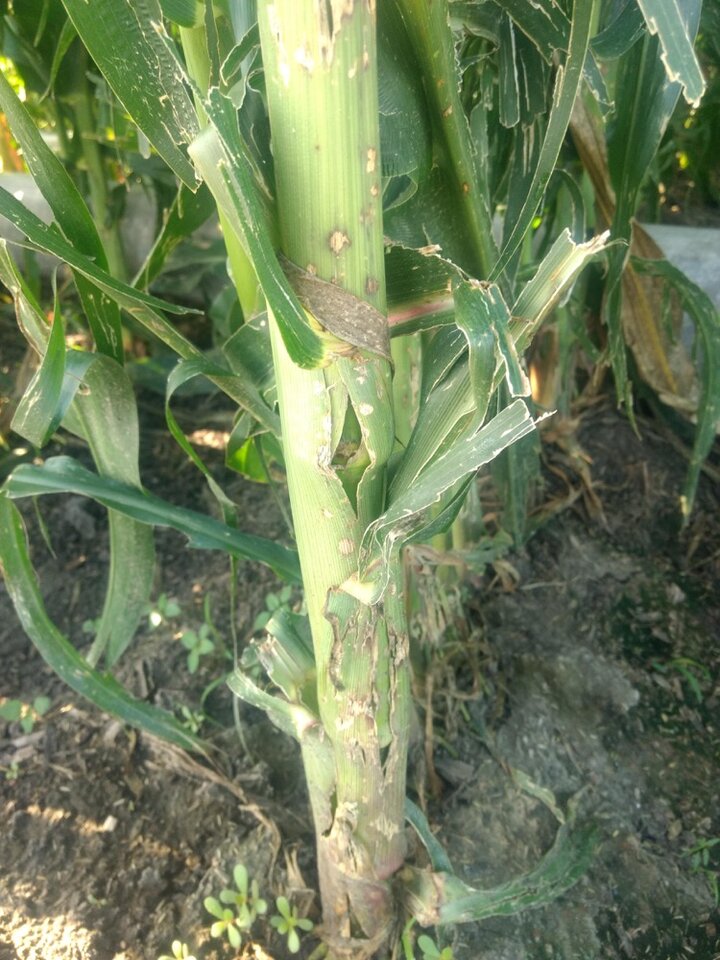Ron Seymour
Extension Educator Adams County
Field surveys were conducted on July 16th and 24th. The areas west and south of Hastings were found to be quite dry resulting in slower growth of dryland crops and pasture grasses.
Corn: With the exception of storm damaged fields, corn looked very good. Plant development ranged from silking to blister stages. Quite a few fields west of Hastings had damage from thunderstorms with up to 40% of the plants snapped off. Several fields east of Minden had moderate hail damage. A number of fields had gray leaf spot and bacterial leaf streak. Although western bean cutworm eggs were not found in surveyed fields, a number of farmers had sufficient infestation to add an insecticide to their fungicide applications. A number of fields had two spotted spider mite infestations on the lower plant leaves (Photo 1).
Soybean: Many soybean fields were still recovering from herbicide injury but for the most part looked very good. Plant development ranged from pod set to pod fill. A number of insects were noticed including grasshoppers, dectes stem borer (Photo 2), bean leaf beetle, green clover worm, Japanese beetle, and thistle caterpillar. Even though there was quite a variety of insects found, feeding damage was light to moderate. Septoria brown spot or bacterial blight was also noticed in several fields.
Alfalfa: Dryland alfalfa looked good where there was soil moisture available otherwise the growth was minimal. Common leaf spot was found on plants. Lygus bugs, green clover worms, and adult alfalfa weevils were common but feeding damage was minimal.


Sarah Sivits
Extension Educator Dawson, Buffalo and Hall Counties
Field corn is anywhere from R1-R3. There have been some reports of southern rust in the area but it’s not widespread at this time. Bacterial leaf streak and small amounts of gray leaf spot are presen,t in addition to common rust and holcus spot. Spray planes have been out over the last couple of weeks spraying fungicides and insecticides. I know several producers sprayed for western bean cutworm and I have seen quite a few fields with rootworm beetle feeding. Seed corn fields are being detasseled right now and look pretty good.
Soybeans range from R3 to early R5 for some early planted varieties. Some fields may still be a little behind, but they are catching up. Japanese beetles are still out and I have seen quite a few fields with thistle caterpillars this summer. I am also seeing some bacterial blight and brown spot in soybeans.
Corn and soybean fields that experienced hail damage a few weeks ago are recovering. I am seeing some goosenecking and irregularly developing ears in fields that were hit with strong winds/greensnap. Some producers had a total loss on their fields that were severely hailed and had to disk them under. Sorghum has developed nice heads and folks are getting ready to take their third cutting of alfalfa soon. Oats have been swathed and baled and a few producers harvested rye (for grain) that was used as a cover crop/forage crop earlier in the season.




Nathan Mueller
Extension Educator Saline, Jefferson and Gage Counties
Most cornfields are in the R3 or milk stage (Figure 1) with a range from blister to dough stage. Rainfall totals over the past week ranged from 0.5 to 4 inches, with most receiving over 1 inch. The UNL Mesonet weather stations near Plymouth and Firth are still showing very good soil moisture at all depths (4, 10, 20, and 40 inches deep). Diseases found include southern rust, northern corn leaf blight, bacterial leaf streak, and gray leaf spot. There has been some field-edge grasshopper pressure in areas. Most soybeans are in the R4 or full pod growth stage (Figure 2), with a range from R3 (beginning pod) to R5 (beginning seed). No significant pest or disease issues other than some hot spots of defoliation from Japanese beetle, but not enough to warrant an insecticide application in most fields. Overall, the corn and soybean crop is in good condition compared to many areas of Nebraska this growing season.
Alfalfa regrowth for third cutting looks good this year after a disappointing first cutting, but good second cutting. Likewise, pasture conditions are good for the end of July due to above average rainfall in most areas during June and July. Wheat harvest finished by the middle of July with average to below average yields with reports for 45 to 75 bushels per acres for rainfed wheat, good test weights above 60 lbs, and adequate protein near or above 12 percent. Winter wheat variety trial results for Jefferson and Lancaster counties is posted on CropWatch and the virtual variety trial tours posted on MediaHub.


